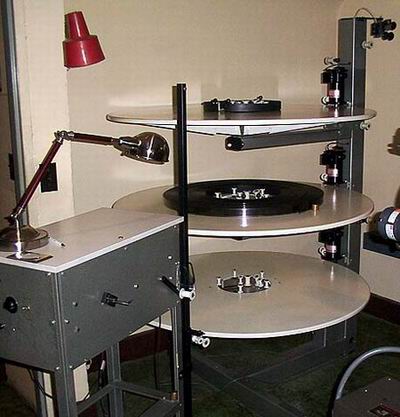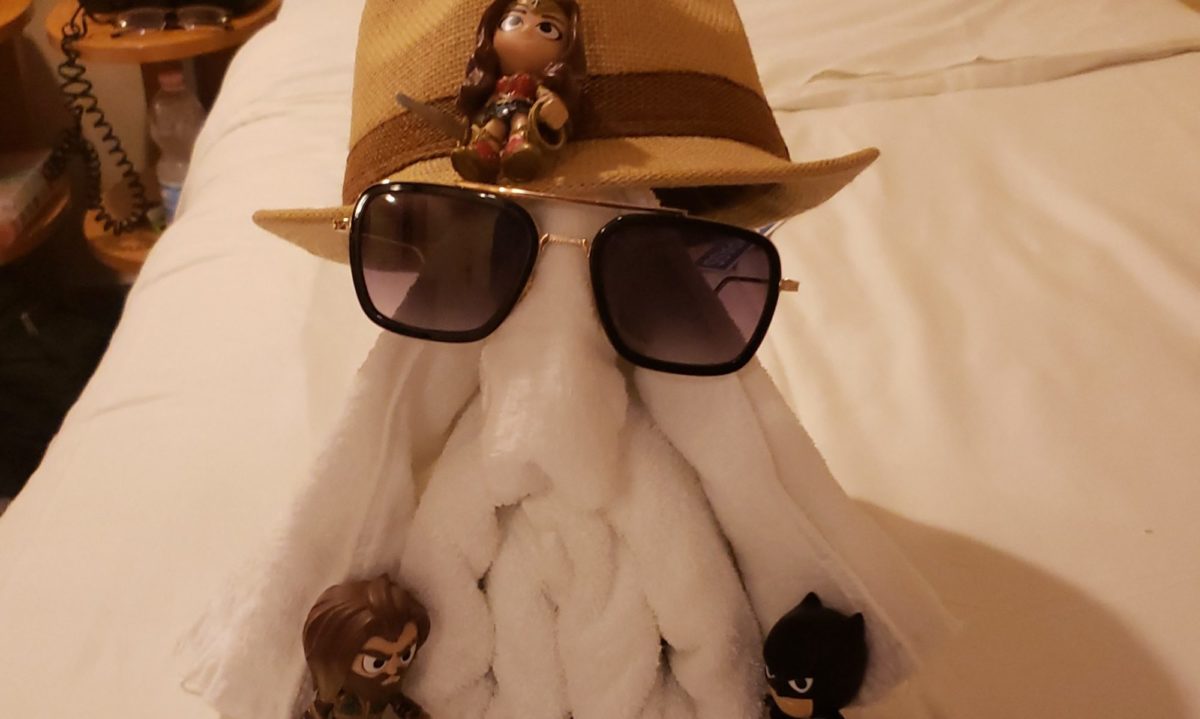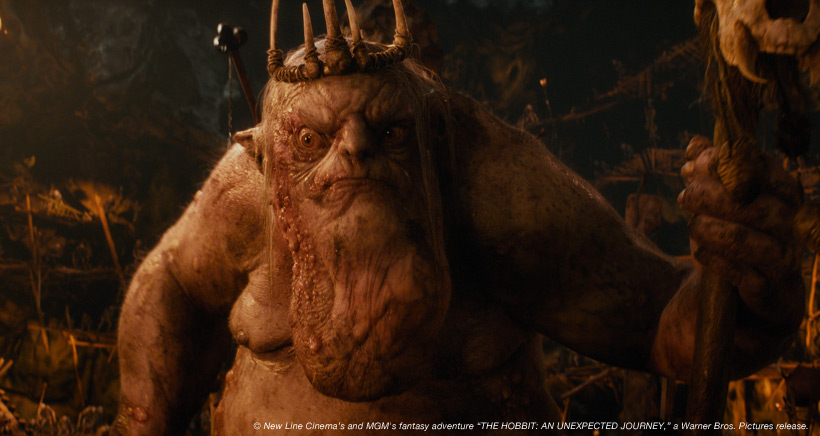And so do we return to a long-forgotten topic: my days as a projectionist. Because I thought I’d take some time and cover an aspect of the movie that most people love but few think about: the trailers. The coming attractions. The twenty minutes of stuff that happens before the actual movie starts.
As a reminder, my experiences come from the before times, from the long-ago, when movies were printed onto physical film which was run through a projector. These days most theatres, certainly most first-run theatres, are digital, so I speak to you now of forgotten arts and witchcraft. The current arts and witchcraft are largely unknown to me.
The Work
One of the chief tasks mid-week for a projectionist was actually building up the prints of the movies about to open. Movies would come in two to three cans of reels, each reel being about twenty minutes’ worth of film. Because in the old days, I’m talking like the 20s here, your light source would last twenty minutes, so that’s how much movie you could show before you switch projectors.
For more on that just watch Fight Club already.
So a movie would be anywhere from five (any cartoon or kid-targeted movie) to nine (Lord of the Rings) reels, with some as short as four and others as long as ten. These reels had to be spliced together and spun onto the projection platters so they were ready to go for Friday.

It’s a fair amount of work. But it’s not the whole process, because in addition to all of that, we had to build the trailer package.
An average film in my first run days had five coming attractions (one or two of which came from the same studio, were attached to the first reel, and had to be cut off), as many as nine corporate ads, and of course the bits of film saying “Coming soon” and “Feature presentation,” and in some cases “Dolby Digital.” Yes, sure, they’re all shorter than a twenty-minute reel, but the thing of it is, the actual time spinning the film onto the larger reel (from which it would be spun onto the platter) is the least amount of work in the whole process. There’s still the splicing, and if it’s a fresh, unused trailer, you had to frame and cut both ends. And if it came from Alliance (like any Lord of the Rings, for instance), you could bet that there was a bad splice (joining of film) between the studio logo and the actual trailer that if left in peace was going to throw the whole movie out of frame.
In short, prepping the trailer package could take as much time as the rest of the movie. Well, no, I’m not sure that’s true. But it took a while, is my point. Especially when a fresh batch of corporate trailers came in.
The urge to be lazy
So what I’m saying is that I get it. I get the urge to be lazy that would hit my various brethren in the projectionist union. You’ve got four movies opening this week, you need to build trailer packages for all of them, the studio just shipped out a fresh trailer for the new Star Wars movie, but they’re all uncut, so of course you’re going to have an urge to just grab the old, already cut teaser off the shelf and throw that on instead.
I understand. But it doesn’t mean I, in any way, ever approved.
See, there can be real problems just grabbing the old trailer. Most notably, the case of the Rollerball remake of 2002. Rollerball, for those who forgot that it ever existed (and who, honestly, could blame you) was supposed to come out in summer of 2001, but at some point after the release of the trailer, it was pushed back (for largely the same reasons that you’ve forgotten it existed), over and over, until finally getting released in February of 2002.
The problem is… when they’d settled on a release date, they sent out a new trailer, but… some of you have probably guessed where this is going… lazy projectionists decided to just grab the old one and throw it on instead. The old one with the Summer 2001 release date. Given that it was already fall of 2001, that just looks bad.
But that’s a rare, isolated case. Most movies only release trailers when they’re sure of when they’re coming out. The real problem is that you’re still short-changing the viewers.
Back then I was at my most sympathetic to the plight of a projectionist. I know very well how much work is involved in making these three prints of Minority Report, plus whatever else you had to deal with, and how little time you were being given. But I paid money to see this movie, and I care about trailers. I know there’s a new, proper trailer for Ang Lee’s Hulk out, so I don’t want to be stuck with the old teaser that’s just 45 seconds of Eric Bana staring in a mirror.
…Wow. To think there was a time in my life when seeing any amount of Ang Lee’s Hulk seemed a good idea. Such an innocent time.
Still, when someone’s desire to save themselves five or ten minutes means I don’t get to see the proper trailer on a proper screen, it was annoying. A let down.
And what really baffles me, right, is that it’s still happening. On digital films. With, I have to assume, digital trailers. Which would imply that it isn’t more work to have the more recent trailer on the movie, as it’s all just electronic files. Could even be pre-loaded by the studio, for all I know. So why, exactly, did Age of Ultron still have the five month old teaser for Star Wars instead of the… well… newer teaser?
Annoying is what it is.
Meanwhile, at the Moviedome
At the Moviedome it was a little faster. Three trailers, three corporate ads at most (including the ever-present anti-piracy spot, the third of which ran until I left because nobody ever told us we could stop running it), and the trailers we had were almost always pre-used. We weren’t even given a list of what to put on the movie, like a first-run theatre would get. The only rule was that the trailers had to be for movies of the same rating or lower than the movie they were on.
A simple rule. Prevents us from putting Texas Chainsaw Massacre trailers on Finding Nemo. But, then, it also prevents us from putting Texas Chainsaw Massacre on Jeepers Creepers or any other horror movie with minimal gore and no nudity.
There aren’t a lot of movies rated 18A. Horror movies, sometimes. American Pie sequels. We’d get one 18A every few months. So if we got an 18A movie in (say, Empire, which you also don’t remember), I made sure to throw every 18A trailer I could on it, and not, say, Treasure Planet, like one of my coworkers wanted to.
This… did result in one leettle hiccup, though. Such was my determination to use whatever 18A trailers I could whenever an 18A feature came a-calling that I gave no thought to the film’s target audience.
We were weeks away from opening Kill Bill vol. 2, The Punisher, and Man on Fire, all 18A-rated revenge movies. Obviously, I’d be able to advertise the other two on whichever opened first. But until then, I only had one 18A feature to run them on…
The Passion of the Christ.
Because, really, why wouldn’t a horde of Christians who’ve come to pretend it was anything other than religious-themed torture porn want to open the feature with a trilogy of ads for violent revenge movies? You’d be crazy to assume they wouldn’t.
So, yeah, kind of regret that one a little.
Anyhoo… see you Friday to talk about the penultimate episode of Writers Circle’s first season.
Should really get around to filming more of those.


